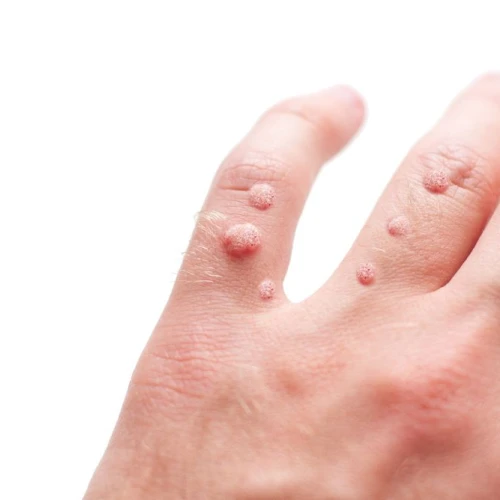How do you recognize a wart on your hand?1, 2, 3
Warts on the hands, also known as common warts, appear as small and round excrescences with a rough surface (grey, yellow, brown or dark grey in colour). You can have single or multiple warts, ranging in size from a few millimetres to 1 cm. Common warts usually occur on the back of the hands and fingers. They can sometimes be found around the nails; in which case they can be very painful. Common warts occurring around the nails (on the cuticles) and under the nails increase the risk of nail abnormalities (deformities, stunted growth, etc.).
What causes warts on your hands?1, 4
Warts on the hands form after the skin is infected by one of the types of human papilloma viruses of which there are many different types (120). These viruses, which are present on the surface of the skin, are able to penetrate the skin through breaches in the protective layer of the skin such as a wound, dry skin, etc. Some skin conditions (e.g. eczema, psoriasis) also favour the penetration of viruses into the epidermis.
Are warts on the hands contagious?4
The viruses responsible for skin warts are contagious.
Direct spreading of warts on the hands
We talk about direct spreading when one infected person passes the virus on to another through skin-to-skin contact. The other direct method of spreading is self-spreading, i.e. viruses in the cells of the wart will spread over the skin when a person scratches themselves. The viruses then spread, which can result in the growth of warts through self-spreading.
Indirect spreading of warts on the hands
Indirect spreading occurs when a person catches the virus through contact with a contaminated surface (ground, tools, etc.) and when it penetrates into damaged skin (minor cut, abrasion, etc.).
Who is at risk? 2, 4
Warts on the hands are more common in people exposed to microtrauma to the skin on their hands (e.g. butchers, fishmongers, vets). People whose hands are constantly immersed in water and people who bite their nails are also more likely to get warts on their hands. Biting your nails also increases the risk of spreading the virus from one nail to another or from a nail to the skin (e.g. the corners of the mouth).
How do you get rid of a wart on your hand?1, 5, 6
Skin warts can heal spontaneously in a few months, but some may persist for several years. In the vast majority of cases, warts will disappear spontaneously within two years. However, they can also be removed quickly using over-the-counter products available from the chemist.
Wart-removal products
You can use wart-removal products that are applied directly on to the wart. These products contain salicylic acid and other corrosive substances that destroy warts by stripping the skin. However, these products should be used with care and should not be used on healthy skin, as there is a risk of burning. They are also contraindicated in children under the age of two years, in pregnant or breast-feeding women, in diabetics and in people with peripheral artery disease of the lower limbs.
Wart-removal treatments should be continued until the wart has disappeared completely, which usually takes 4 to 8 weeks.
Occlusive dressings
To remove a wart, you can also use an occlusive dressing. This type of dressing is air and water-tight, which prevents the skin from breathing and, therefore, removes the wart. The dressing should be used for several weeks, until the wart has disappeared. When used with wart-removal products, the occlusive dressing increases the penetration of these products into the skin. Occlusive dressings cannot be used too close to nails.
Cryotherapy kits
Cryotherapy is a method that involves freezing the wart down to its root by applying liquid nitrogen directly to the wart using a fine nozzle attached to an aerosol bottle. The wart and its root, which are completely frozen for very short time, will then begin a natural elimination process. About ten days later, the wart will drop off spontaneously, revealing new, healthy skin. A single application may be enough to remove the wart, except if the wart is especially stubborn. The product then needs to be re-applied two weeks later.
If the self-medication products do not work, patients should consult their general practitioner or a dermatologist. More powerful treatments to remove warts on the hands are available (e.g. liquid nitrogen cryotherapy, surgical currettage, carbon dioxide laser). However, it’s important to remember that no treatment is currently available to eradicate the viruses responsible for warts, which explains the frequent recurrences.


